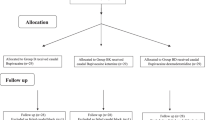Abstract
Purpose
Emergence delirium (ED) is a common postoperative complication of ambulatory pediatric surgery done under general anesthesia with sevoflurane. However, perioperative analgesic techniques have been shown to reduce sevoflurane-induced ED. The primary objective of this investigation was to examine whether an ultrasound-guided ilioinguinal/iliohypogastric (II/IH) nerve block for ambulatory pediatric inguinal hernia repair could reduce the incidence of sevoflurane-induced ED.
Methods
The subjects of this prospective randomized double-blind study were 40 boys ranging in age from 1 to 6 years, who were scheduled to undergo ambulatory inguinal hernia repair. The patients were randomized to either receive or not to receive an ultrasound-guided II/IH nerve block (Group B and Group NB, respectively). General anesthesia was maintained with sevoflurane and nitrous oxide. The primary outcome assessed was ED, evaluated using the Pediatric Anesthesia Emergence Delirium (PAED) scale 30 min after emergence from general anesthesia. The secondary outcomes assessed were postoperative pain, evaluated using the Behavioral Observational Pain Scale (BOPS), and the amount of intra-operative sevoflurane given.
Results
The median PAED scale scores did not differ between Groups B and NB at 30 min (P = 0.41). BOPS scores also did not differ significantly between the groups, but the mean amount of intraoperative sevoflurane given was significantly lower in Group B than in Group NB (P < 0.01).
Conclusions
Ultrasound-guided II/IH nerve block for ambulatory pediatric inguinal hernia repair did not reduce ED, but it did decrease the amount of intra-operative sevoflurane needed.
Clinical Trial Registration: UMIN000008586.



Similar content being viewed by others
References
Lerman J. Inhalational anesthetics. Paediatr Anaesth. 2004;14:380–3.
Welborn LG, Hannallah RS, Norden JM, Ruttimann UE, Callan CM. Comparison of emergence and recovery characteristics of sevoflurane, desflurane, and halothane in pediatric ambulatory patients. Anesth Analg. 1996;83:917–20.
Ibacache ME, Muñoz HR, Brandes V, Morales AL. Single-dose dexmedetomidine reduces agitation after sevoflurane anesthesia in children. Anesth Analg. 2004;98:60–3.
Aouad MT, Yazbeck-Karam VG, Nasr VG, El-Khatib MF, Kanazi GE, Bleik JH. A single dose of propofol at the end of surgery for the prevention of emergence agitation in children undergoing strabismus surgery during sevoflurane anesthesia. Anesthesiology. 2007;107:733–8.
Cohen IT, Finkel JC, Hannallah RS, Hummer KA, Patel KM. The effect of fentanyl on the emergence characteristics after desflurane or sevoflurane anesthesia in children. Anesth Analg. 2002;94:1178–81.
Cohen IT, Hannallah RS, Hummer KA. The incidence of emergence agitation associated with desflurane anesthesia in children is reduced by fentanyl. Anesth Analg. 2001;93:88–91.
Voepel-Lewis T, Malviya S, Tait AR. A prospective cohort study of emergence agitation in the pediatric postanesthesia care unit. Anesth Analg. 2003;96:1625–30.
Willschke H, Marhofer P, Bösenberg A, Johnston S, Wanzel O, Cox SG, et al. Ultrasonography for ilioinguinal/iliohypogastric nerve blocks in children. Br J Anaesth. 2005;95:226–30.
Weintraud M, Marhofer P, Bösenberg A, Kapral S, Willschke H, Felfernig M, et al. Ilioinguinal/iliohypogastric blocks in children: where do we administer the local anesthetic without direct visualization? Anesth Analg. 2008;106:89–93.
Willschke H, Bösenberg A, Marhofer P, Johnston S, Kettner S, Eichenberger U, et al. Ultrasonographic-guided ilioinguinal/iliohypogastric nerve block in pediatric anesthesia: what is the optimal volume? Anesth Analg. 2006;102:1680–4.
Warren-Stomberg M, Brattwall M, Jakobsson JG. Non-opioid analgesics for pain management following ambulatory surgery: a review. Minerva Anestesiol. 2013;79:1077–87.
Sikich N, Lerman J. Development and psychometric evaluation of the pediatric anesthesia emergence delirium scale. Anesthesiology. 2004;100:1138–45.
Hesselgard K, Larsson S, Romner B, Strömblad LG, Reinstrup P. Validity and reliability of the Behavioural Observational Pain Scale for postoperative pain measurement in children 1–7 years of age. Pediatr Crit Care Med. 2007;8:102–8.
Kim HS, Kim CS, Kim SD, Lee JR. Fascia iliaca compartment block reduces emergence agitation by providing effective analgesic properties in children. J Clin Anesth. 2011;23:119–23.
Isik B, Arslan M, Tunga AD, Kurtipek O. Dexmedetomidine decreases emergence agitation in pediatric patients after sevoflurane anesthesia without surgery. Paediatr Anaesth. 2006;16:748–53.
Cravero JP, Beach M, Thyr B, Whalen K. The effect of small dose fentanyl on the emergence characteristics of pediatric patients after sevoflurane anesthesia without surgery. Anesth Analg. 2003;97:364–7.
Julius D, Basbaum AI. Molecular mechanisms of nociception. Nature. 2001;413:203–10.
Cunha FQ, Poole S, Lorenzetti BB, Ferreira SH. The pivotal role of tumour necrosis factor alpha in the development of inflammatory hyperalgesia. Br J Pharmacol. 1992;107:660–4.
Gürleyik E, Gürleyik G, Cetinkaya F, Unalmiser S. The inflammatory response to open tension-free inguinal hernioplasty versus conventional repairs. Am J Surg. 1998;175:179–82.
Cohen IT, Finkel JC, Hannallah RS, Hummer KA, Patel KM. Rapid emergence does not explain agitation following sevoflurane anaesthesia in infants and children: a comparison with propofol. Paediatr Anaesth. 2003;13:63–7.
Shen X, Dong Y, Xu Z, Wang H, Miao C, Soriano SG, et al. Selective anesthesia-induced neuroinflammation in developing mouse brain and cognitive impairment. Anesthesiology. 2013;118:502–15.
Jevtovic-Todorovic V, Hartman RE, Izumi Y, Benshoff ND, Dikranian K, Zorumski CF, et al. Early exposure to common anesthetic agents causes widespread neurodegeneration in the developing rat brain and persistent learning deficits. J Neurosci. 2003;23:876–82.
Birmingham PK, Tobin MJ, Fisher DM, Henthorn TK, Hall SC, Coté CJ. Initial and subsequent dosing of rectal acetaminophen in children: a 24-hour pharmacokinetic study of new dose recommendations. Anesthesiology. 2001;94:385–9.
Schmidt A, Björkman S, Akeson J. Preoperative rectal diclofenac versus paracetamol for tonsillectomy: effects on pain and blood loss. Acta Anaesthesiol Scand. 2001;45:48–52.
Gandhi R, Sunder R. Postoperative analgesic efficacy of single high dose and low dose rectal acetaminophen in pediatric ophthalmic surgery. J Anaesthesiol Clin Pharmacol. 2012;28:460–4.
Acknowledgments
We thank Dr. Masayuki Ohashi at the Niigata University Graduate School of Medical and Dental Sciences for his useful suggestions.
Author information
Authors and Affiliations
Corresponding author
Ethics declarations
Conflict of interest
We have no conflicts of interest to declare.
Rights and permissions
About this article
Cite this article
Ohashi, N., Denda, S., Furutani, K. et al. Ultrasound-guided ilioinguinal/iliohypogastric block did not reduce emergence delirium after ambulatory pediatric inguinal hernia repair: a prospective randomized double-blind study. Surg Today 46, 963–969 (2016). https://doi.org/10.1007/s00595-015-1280-6
Received:
Accepted:
Published:
Issue Date:
DOI: https://doi.org/10.1007/s00595-015-1280-6




